1. Introduction
With the increasing number of wireless communication users, future mobile communication systems are expected to improve communication rates and data transmission efficiency, as well as enhance the reliability and security of communication networks. However, conventional wireless communication systems face many challenges, including shortage of spectrum resources, poor signal transmission quality, and high energy consumption of terminal devices.
Reconfigurable Intelligent Surfaces (RIS), as one of the promising technologies to support future mobile communications, has become a hot research topic, and RIS can significantly improve the communication performance by intelligently configuring the propagation characteristics of wireless environments by changing the parameters of electromagnetic waves such as amplitude, phase, and frequency.
In this paper, we will focus on combing the research status, key technologies and future development trends of RIS-assisted wireless communications. Specifically, the rest of the paper is organized as follows: chapters 2 and 3 successively provide an overview of RIS technology and common wireless communication technologies. Chapter 4 focuses on the current research status of RIS-assisted wireless communications, Chapter 5 analyzes the opportunities and challenges of RIS technology, and Chapter 6 provides a summary and outlook.
2. RIS Technology
RIS is a hyper-surface with a large number of small passive components attached, which builds an intelligent wireless environment by controlling parameters such as the phase and amplitude of incident electromagnetic waves. Compared with traditional wireless communications, RIS is characterized by low cost, low energy consumption, programmability, and ease of deployment. However, RIS technology also introduces the "multiplicative fading" effect, which leads to limited capacity gain [1].RIS is mainly categorized into two types: RIS and active RIS, which are described as follows.
2.1. Passive RIS
Passive RIS is an array composed of a large number of passive components, passively reflecting signals through phase-shifting circuits, with negligible DC power consumption, introduced thermal noise, but unable to amplify signals. Theoretically, RIS can achieve a signal-to-noise gain proportional to the square of the number of surface cells, but the "multiplicative fading" effect makes the actual gain of RIS in typical communication scenarios with strong direct-radial paths negligible, and this fundamental problem that restricts the wide application of RIS has not been completely solved.
Based on its ability to regulate the wireless channel, passive RIS can realize the functions of coverage blindness mending, edge coverage enhancement, and multi-stream speed increase in traditional communication scenarios. For 6G, passive RIS can solve the channel rank loss problem of high-frequency communication, and it also has many potential applications in the fields of spatial communication, three-dimensional localization, wireless edge computing, etc., which can improve the channel quality, enhance the signal, and thus improve the transmission performance.
2.2. Active RIS
Passive RIS is an array composed of a large number of passive components, passively reflecting signals through phase-shifting circuits, with negligible DC power consumption, introduced thermal noise, but unable to amplify signals. Theoretically, RIS can achieve a signal-to-noise gain proportional to the square of the number of surface cells, but the "multiplicative fading" effect makes the actual gain of RIS in typical communication scenarios with strong direct-radial paths negligible, and this fundamental problem that restricts the wide application of RIS has not been completely solved.
Based on its ability to regulate the wireless channel, passive RIS can realize the functions of coverage blindness mending, edge coverage enhancement, and multi-stream speed increase in traditional communication scenarios. For 6G, passive RIS can solve the channel rank loss problem of high-frequency communication, and it also has many potential applications in the fields of spatial communication, three-dimensional localization, wireless edge computing, etc., which can improve the channel quality, enhance the signal, and thus improve the transmission performance.
2.3. RIS Key Technologies
The key technologies of RIS include hardware structure and regulation, baseband algorithm and network design. The hardware part focuses on the reconfigurable electromagnetic surface structure and the design of the control system. The baseband algorithm includes channel modeling, channel estimation, and beam assignment. The network design refers to RIS network deployment and solving the network coexistence problem introduced by RIS.
3. Wireless Communication Technology
Wireless communication utilizes the characteristics of electromagnetic wave signals propagating in free space for information exchange. Wireless communication can be divided into microwave communication, satellite communication, optical fiber communication, mobile communication, and UAV communication, etc., and these technologies together build a communication network system that covers the whole society. So far, the commercialization of 5G has expanded mobile communication from "people connection" to "things connection", and on the basis of 5G, 6G will integrate the capabilities of communication, perception, and computation, and move towards the intelligent connection of all things.
3.1. Microwave Communication
Microwave communication is the use of electromagnetic waves (microwaves) with a wavelength between 0.1 mm and 1 meter. Microwaves are easy to focus, have high information carrying capacity, high frequency and large bandwidth, but can only propagate along a straight line, so they are widely used in point-to-point communication networks, deep-space radio communications, satellite communications and other fields. Different parts of the microwave radio spectrum are used in radio astronomy, sensor systems, radio navigation and radar.
3.2. Satellite Communication
Satellite communication is the communication between radio communication stations on earth using satellites as relays, which has the advantages of long communication distance, large communication capacity, large coverage area and good mobility. Typical satellite communication systems mainly include broadband satellite communication system, data relay satellite system and military satellite communication system. At present, the development frontiers of satellite communications are high-throughput communication satellites and low-orbit broadband satellites.
3.3. Optical fiber Communication
Fiber-optic communication is a communication mode with light wave as carrier frequency and optical fiber as transmission medium, with larger bandwidth and capacity than microwave communication, long relay distance and strong confidentiality, but with low mechanical strength, and inflexible splitting and coupling. Fiber-optic communication is mainly used for municipal telephone trunks, global communication networks, public telecommunication networks in various countries, and will further realize ultra-high-speed rate, ultra-large capacity and ultra-long-distance transmission in the future.
3.4. Mobile Communication
Mobile communication is a communication in which at least one of the two parties to the communication is on the move, with complex wave propagation conditions, serious noise and interference, and complex system and network structure. Each generation of mobile communication technology has been significantly improved: voice communication in 1G, SMS and MMS in 2G, video call in 3G, mobile Internet in 4G, and "Internet of Everything" in 5G.
3.5. UAV Communication
UAV communication is the communication of information exchange between unmanned aerial vehicles or with ground control stations, with line-of-sight channels, high mobility, easy to deploy and other advantages. UAV communication will be a powerful auxiliary of 6G in star-ground converged network architecture and ground mobile communication, and it can also realize the scenarios and functions such as UAV base station swarm system, UAV holographic projection system, UAV relay network, and data collection.
4. Research Status of Ris-Assisted Wireless Communication
In recent years, the research on RIS-assisted wireless communication has made significant progress, mainly focusing on four aspects: hardware regulation, baseband algorithm, multi-access enhancement and network design.
4.1. Hardware Regulation
Most of the existing research assumes that the hardware in the transceiver and RIS is perfect. In fact, hardware defects can adversely affect the performance of wireless systems. Literature [2] investigates a RIS-assisted multi-user multi-input single-output system as shown in Fig. 1. The model has transceivers and RIS with imperfect Channel State Information (CSI) and hardware interruptions, and a computationally efficient Reflective Beamforming (RB) optimization method is employed, following which the impact of hardware defects on the system's spectral efficiency is evaluated.
In addition, Hardware Impairments (HWIs) caused by the environment are also important factors affecting the performance of communication systems. In order to effectively grow the service life of RIS, the communication network environment assisted by RIS must be accurately analyzed. However, the complexity of the actual wireless environment and the intensive nature of RIS deployments have caused most of the existing work to avoid studying the reliability of the communication network under operating conditions. As shown in Fig. 2, Mondal et al. simulated the RIS environment of RIS-assisted communication networks using statistics by incorporating non-residual stochastic RIS hardware impairments through stochastic modeling, which led to the development of an e-maintenance framework for RIS to determine the optimal time point for hardware maintenance. However, the simulation uses only a single antenna for both the transmitter and receiver, leaving open the possibility of a more complex and realistic system architecture [3].
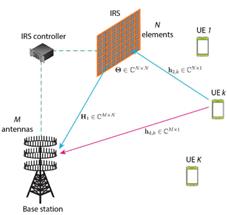
|
|
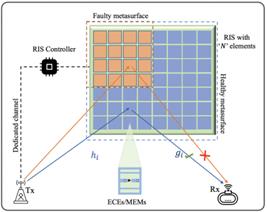
|
Figure 1. RIS-assisted MU-MISO communication system. |
|
Figure 2. Inaccurate reflections from a faulty RIS element may lead to communication disruption. |
4.2. Baseband Algorithms
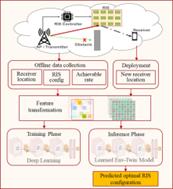
|
|
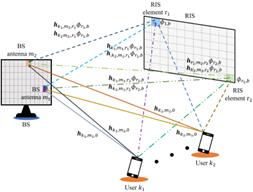
|
Figure 3. Framework of the model learning and inference phases. |
|
Figure 4. RIS-assisted multi-antenna BS and single-antenna user system. |
Baseband algorithms include channel modeling, channel estimation, and beam assignment, as described below.
4.2.1. Channel Modeling
The wireless channel is the channel for signal propagation, and the wireless channel model is the basis for the design, optimization and evaluation of the wireless network system. Nowadays, artificial intelligence has been widely used in wireless communications. Sheen et al. [4] proposed a machine learning based channel modeling method and used a deep learning model to predict the optimal RIS configuration, which resulted in the best performance of this RIS-assisted wireless communication network, as shown in Fig. 3. It is worth noting that the model does not consider CSI and thus ignores the real-time impact of the state of the wireless network facilities.
4.2.2. Channel Estimation
Through channel estimation, the receiver obtains the impulse response of the channel, which provides CSI for coherent demodulation. Most of the existing channel estimation methods only estimate the cascaded channels between Base Station (BS), RIS, and User Equipment (UE), and cascaded channel estimation methods have a very high pilot overhead, which limits the spectral efficiency and leads to the Hu et al. [5] proposed a dual time-scale channel estimation framework that exploits the high-dimensional but quasi-static nature of the BS-RIS channel and the lowdimensional but dynamic nature of the RIS-UE channel to achieve more accurate channel estimation with lower guide frequency overhead. This framework assumes that the RIS is passive and the system is single-input-multi-output, as shown in Fig. 4.
For Multi-User Multiple-Input Multiple-Output (Mu-MIMO) systems, Jeong et al. [6] proposed a joint carrier frequency bias and channel estimation method, which improves the Normalized Mean Squared Error (NMSE) of channel estimation. Squared Error (NMSE) and Bite Error Rate (BER) performance, while the method has lower cost, computational complexity, and conduction overhead, but lacks consideration of multi-user interference.
4.2.3. Beam Shaping
RIS is capable of Passive Beamforming (P-BF), i.e., focusing the energy by modulating the phase of the reflected electromagnetic waves to improve the performance of the wireless network. The design of the RIS structure is an effective way to realize the desired beam fouling, for example, Rao et al. [7] designed a novel RIS with highly reconfigurable elements, where each RIS element consists of 5 × 5 sub-elements and 4 RF switches for passive beamforming over a wide range of incidence and reflection angles, as shown in Fig. 5. The beamforming characteristics of this new RIS fit the requirements of high-capacity communication systems, but it still needs to be optimized in terms of complexity.
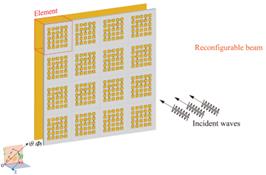
|
|
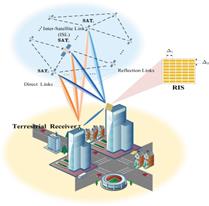
|
Figure 5. Schematic diagram of RIS constructed from 4×4 elements. |
|
Figure 6. Schematic diagram of RIS-assisted multi-satellite cooperative downlink transmission. |
In terms of cooperative beam fouling, for the RIS-assisted multi-satellite communication system, as shown in Fig. 6, Feng et al. [8] proposed a joint scheme of RIS passive beam forming and multi-satellite active beam fouling, which improves the received signal power, and obtains the optimal beam fouling design by using an alternating optimization algorithm to enhance the system performance.
4.3. Multiple Access Enhancement
Multiple access technology is the key technology to realize efficient sharing of wireless resources by multiple users, which is generally divided into two categories, Orthogonal Multiple Access (OMA) and Non-Orthogonal Multiple Access (NOMA). With the continuous evolution of wireless communication, the traditional OMA technology can no longer meet the requirements, and 5G has begun to adopt NOMA technology. Zhong et al. [9] combined with artificial intelligence, proposed environment trained deep learning (ETDL) algorithm and exploration attenuated deep deterministic policy gradient (EA-DDPG) algorithm to weigh the time overhead of RIS reflection element configuration. The flowcharts of ETDL algorithm and EA-DDPG algorithm are shown in Fig. 7 and Fig. 8, respectively. The results show that the RIS-assisted NOMA network model can achieve greater gains compared to the OMA model. However, the study only considered single antenna transmission and was not applicable to multi-antenna transmission.

Figure 7. Flowchart of the ETDL algorithm
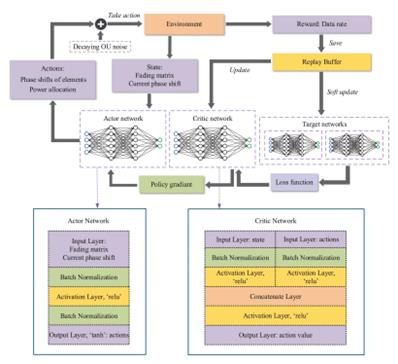
Figure 8. Flowchart of the EA-DDPG algorithm
The assistance of RIS can optimize the NOMA technique. Makin et al. [10] proposed a technique for dividing the RIS to optimize the user channel conditions in a two-way NOMA network, which improves the NOMA gain and removes the need for power control in the uplink, providing a better communication experience for the user. It is worth noting that the study does not consider the impact of imperfect continuous interference cancellation and CSI on the system.
4.4. Networking Design
The introduction of RIS may lead to more serious coexistence problems in wireless networks, negatively affecting network performance. Literature [11] proposes two new RIS structures, including a new multilayer RIS structure with out-of-band filter and RIS blocking mechanism, which can effectively solve the RIS network coexistence problem, but it is mainly applicable to different band coexistence scenarios, and the solution for same band coexistence scenarios is still to be studied.
5. Opportunities and Challenges for RIS in Wireless Communications
5.1. Opportunities
The rapid development of RIS-assisted wireless communication technology brings many opportunities for future communication systems. RIS can be used to build new types of antennas, filters, isolators, gainers, and other wireless communication equipment by modulating electromagnetic waves to achieve signal modulation, enhancement, and filtering, thus realizing more efficient, reliable, and flexible wireless communication.
In 5G and future wireless communication technologies, RIS is expected to become an important technical means for realizing more high-speed, large-capacity and low-power wireless communication systems. At the same time, RIS can also be used to solve interference and isolation problems in wireless communications and improve the quality and reliability of communication systems.
5.2. Challenges
Although RIS technology demonstrates great potential, it still faces many challenges in practical applications. First, in general, a large number of studies on RIS are based on relatively simple and ideal models, which only consider single antenna transmission, or even single base station and single user. In order to realize the engineering application of RIS, future research needs to consider more complex and realistic models.
Second, most of the existing studies are based on some perfect assumptions, including perfect CSIs, HWIs, and so on. These perfect assumptions face realistic challenges. For example, the passive components of RIS are energy efficient but make it difficult to collect CSI. The traditional method of adjusting the IRS phase shift based on statistically derived CSI is not suitable for high-speed dynamically changing channels, and it is more challenging to adjust the parameters of RIS based on instantaneously acquired CSI [12].
The "multiplicative fading" effect introduced by RIS cannot be ignored. When the application of passive RIS is limited by distance, hybrid RIS and active RIS emerge. The addition of active components makes the thermal noise and DC power consumption non-negligible, the hardware cost may become larger, and the complexity of channel estimation increases. How to effectively balance the gain and cost is a worthy breakthrough for future research.
6. Summary and Outlook
This paper examines the recent advancements and development tendencies of RIS-assisted wireless communication technology. As the number of communication users continues to grow, it is imperative to enhance communication rates and transmission efficiency. RIS offers a promising solution to this challenge by enabling the realization of high-speed, large-capacity, and low-power wireless communication systems through the modulation of electromagnetic waves to modulate and enhance signals. This paper initially presents the basic principles of RIS and wireless communication, thereby establishing a theoretical foundation for research pertaining to RIS-assisted wireless communication. Subsequently, Chapter 4 of this paper provides elaboration on the current status of research in the field of RIS-assisted wireless communication. This includes an examination of four key aspects: hardware regulation, baseband algorithms, multi-access enhancement, and network design. The extant literature demonstrates that the integration of RIS technology into wireless communication systems has the potential to enhance data and user capacity, improve spectral efficiency, and facilitate the future development of wireless communication systems.
Nevertheless, research in the field of RIS technology in wireless communication is still in its nascent stages of development. The models employed in existing studies may exhibit a degree of idealization, with a discrepancy between their findings and the actual communication scenarios. Additionally, some of the channel estimation methods have limited applicability, necessitating further investigation. The potential for RIS technology to advance wireless communication is vast, spanning mobile communication, satellite communication, UAV communication, and other fields. It is anticipated that further breakthroughs will occur in the future.
References
[1]. Zhang Z, Dai L, Chen X, et al. Active RIS vs. passive RIS: Which will prevail in 6G?[J]. IEEE Transactions on Communications, 2022, 71(3): 1707-1725.
[2]. Papazafeiropoulos A, Pan C, Kourtessis P, et al. Intelligent reflecting surface-assisted MU-MISO systems with imperfect hardware: Channel estimation and beamforming design[J]. IEEE Transactions on Wireless Communications, 2021, 21(3): 2077-2092.
[3]. Mondal A, Ghosh S, Singh K, et al. Extending RIS Life Span for Reliable Communication Under Hardware Ageing Effects[J]. IEEE Open Journal of the Communications Society, 2024, 5: 3395-3409.
[4]. Sheen B, Yang J, Feng X, et al. A deep learning based modeling of reconfigurable intelligent surface assisted wireless communications for phase shift configuration[J]. IEEE Open Journal of the Communications Society, 2021, 2: 262-272.
[5]. Hu C, Dai L, Han S, et al. Two-timescale channel estimation for reconfigurable intelligent surface aided wireless communications[J]. IEEE Transactions on Communications, 2021, 69(11): 7736-7747.
[6]. Jeong S, Farhang A, Perović N S, et al. Joint CFO and channel estimation for RIS-aided multi-user massive MIMO systems[J]. IEEE Transactions on Vehicular Technology, 2023, 72(9): 11800-11813.
[7]. Rao J, Zhang Y, Tang S, et al. A novel reconfigurable intelligent surface for wide-angle passive beamforming[J]. IEEE Transactions on Microwave Theory and Techniques, 2022, 70(12): 5427-5439.
[8]. Feng K, Zhou T, Xu T, et al. Reconfigurable Intelligent Surface-Assisted Multi-Satellite Cooperative Downlink Beamforming[J]. IEEE Internet of Things Journal, 2024, 11(13): 23222-23235.
[9]. Zhong R, Liu Y, Mu X, et al. AI empowered RIS-assisted NOMA networks: Deep learning or reinforcement learning?[J]. IEEE Journal on Selected Areas in Communications, 2021, 40(1): 182-196.
[10]. Makin M, Arzykulov S, Celik A, et al. Optimal RIS partitioning and power control for bidirectional NOMA networks[J]. IEEE Transactions on Wireless Communications, 2023, 23(4): 3175-3189.
[11]. Zhao Y, Lv X. Network coexistence analysis of RIS-assisted wireless communications[J]. IEEE Access, 2022, 10: 63442-63454.
[12]. Jia Y, Ye C, Cui Y. Analysis and optimization of an intelligent reflecting surface-assisted system with interference[J]. IEEE Transactions on Wireless Communications, 2020, 19(12): 8068-8082.
Cite this article
Zhu,Z. (2024). A review of RIS-assisted wireless communication research. Applied and Computational Engineering,88,158-165.
Data availability
The datasets used and/or analyzed during the current study will be available from the authors upon reasonable request.
Disclaimer/Publisher's Note
The statements, opinions and data contained in all publications are solely those of the individual author(s) and contributor(s) and not of EWA Publishing and/or the editor(s). EWA Publishing and/or the editor(s) disclaim responsibility for any injury to people or property resulting from any ideas, methods, instructions or products referred to in the content.
About volume
Volume title: Proceedings of the 6th International Conference on Computing and Data Science
© 2024 by the author(s). Licensee EWA Publishing, Oxford, UK. This article is an open access article distributed under the terms and
conditions of the Creative Commons Attribution (CC BY) license. Authors who
publish this series agree to the following terms:
1. Authors retain copyright and grant the series right of first publication with the work simultaneously licensed under a Creative Commons
Attribution License that allows others to share the work with an acknowledgment of the work's authorship and initial publication in this
series.
2. Authors are able to enter into separate, additional contractual arrangements for the non-exclusive distribution of the series's published
version of the work (e.g., post it to an institutional repository or publish it in a book), with an acknowledgment of its initial
publication in this series.
3. Authors are permitted and encouraged to post their work online (e.g., in institutional repositories or on their website) prior to and
during the submission process, as it can lead to productive exchanges, as well as earlier and greater citation of published work (See
Open access policy for details).
References
[1]. Zhang Z, Dai L, Chen X, et al. Active RIS vs. passive RIS: Which will prevail in 6G?[J]. IEEE Transactions on Communications, 2022, 71(3): 1707-1725.
[2]. Papazafeiropoulos A, Pan C, Kourtessis P, et al. Intelligent reflecting surface-assisted MU-MISO systems with imperfect hardware: Channel estimation and beamforming design[J]. IEEE Transactions on Wireless Communications, 2021, 21(3): 2077-2092.
[3]. Mondal A, Ghosh S, Singh K, et al. Extending RIS Life Span for Reliable Communication Under Hardware Ageing Effects[J]. IEEE Open Journal of the Communications Society, 2024, 5: 3395-3409.
[4]. Sheen B, Yang J, Feng X, et al. A deep learning based modeling of reconfigurable intelligent surface assisted wireless communications for phase shift configuration[J]. IEEE Open Journal of the Communications Society, 2021, 2: 262-272.
[5]. Hu C, Dai L, Han S, et al. Two-timescale channel estimation for reconfigurable intelligent surface aided wireless communications[J]. IEEE Transactions on Communications, 2021, 69(11): 7736-7747.
[6]. Jeong S, Farhang A, Perović N S, et al. Joint CFO and channel estimation for RIS-aided multi-user massive MIMO systems[J]. IEEE Transactions on Vehicular Technology, 2023, 72(9): 11800-11813.
[7]. Rao J, Zhang Y, Tang S, et al. A novel reconfigurable intelligent surface for wide-angle passive beamforming[J]. IEEE Transactions on Microwave Theory and Techniques, 2022, 70(12): 5427-5439.
[8]. Feng K, Zhou T, Xu T, et al. Reconfigurable Intelligent Surface-Assisted Multi-Satellite Cooperative Downlink Beamforming[J]. IEEE Internet of Things Journal, 2024, 11(13): 23222-23235.
[9]. Zhong R, Liu Y, Mu X, et al. AI empowered RIS-assisted NOMA networks: Deep learning or reinforcement learning?[J]. IEEE Journal on Selected Areas in Communications, 2021, 40(1): 182-196.
[10]. Makin M, Arzykulov S, Celik A, et al. Optimal RIS partitioning and power control for bidirectional NOMA networks[J]. IEEE Transactions on Wireless Communications, 2023, 23(4): 3175-3189.
[11]. Zhao Y, Lv X. Network coexistence analysis of RIS-assisted wireless communications[J]. IEEE Access, 2022, 10: 63442-63454.
[12]. Jia Y, Ye C, Cui Y. Analysis and optimization of an intelligent reflecting surface-assisted system with interference[J]. IEEE Transactions on Wireless Communications, 2020, 19(12): 8068-8082.









